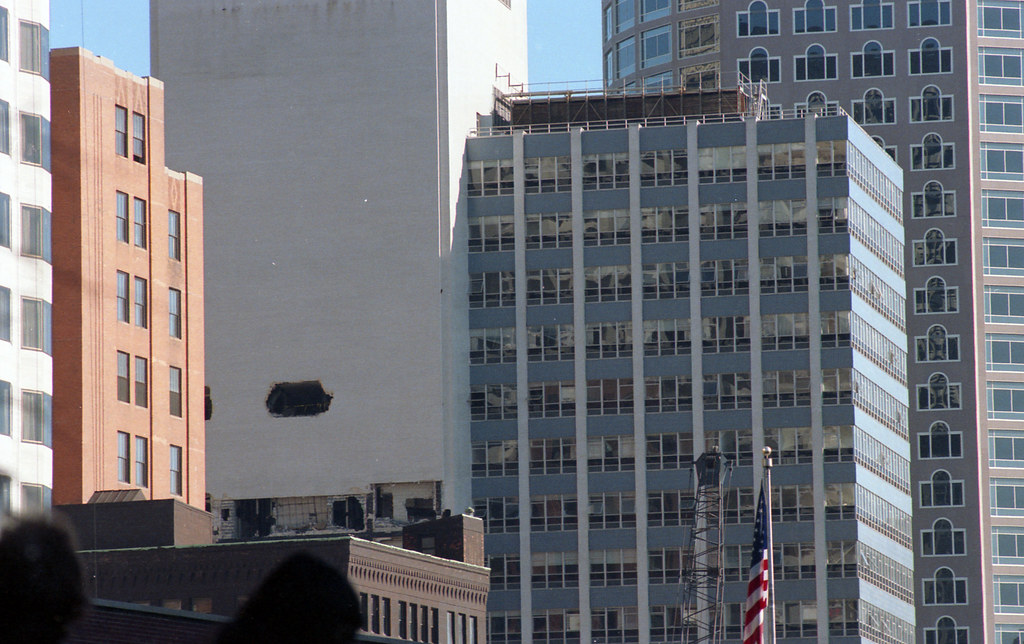A High Street Enhancement
SUNDAY, DECEMBER 7. 1986
The blue-and-white tower of bathroom tile will soon be demolished and few will mourn. When the Travelers Insurance Building on High Street was built in 1959, Bostonians swooned like so many carnival rubes. Boston was hungry for any new buildings and took what it could get.
The skyscraper plunked on an empty plaza was the American building style for decades. The demolition of the Travelers and its handsome replacement represent one of the most agreeable developments in Boston in years.
The new 125 High St. presents what we hope is an enduring innovation in Boston, a pedestrian-friendly building that graces the skyline. On a site that could handle a megalith of the brutal-glass-box school of architecture, the Travelers proposes a more soothing, varied complex. Retail arcades and an atrium will link Art Deco-style towers with a boxlike building echoing other financial district structures.
As modern architecture stumbles through its phases of proto-post- modernism, the most forgotten victims are the people who work and live in these buildings, as well as pedestrians. The dictum of Ludwig Mies van der Rohe, "Less is more," created cold plazas that theoretically created open space in dense downtowns.
The new Travelers effort realizes that private, profitable arcades serve the public better than empty "public" spaces. The architects, Jung/Brannen • Associates, designed the Dewey Square tower, a 1970s slab that is almost the antithesis of this project. Architects and developers can learn.
A deep-pockets owner, Travelers, with a reliable tenant, New England Telephone, has concluded that giant filing cabinets are less attractive and less profitable than carefully planned, inviting urban vistas. Travelers is preserving several 19th-century buildings on the site for rentability, not sentiment.
The present tower is an icicle of the 1950s, resembling the coldness of Charles River Park. The new version will be more truly modern. At 125 High St. there may rise a more valid interpretation of "less is more."
By the way the higher tower was chopped from 600' as originally proposed to the "more appropriate" 400 and other "improvements" were made
Working with the BRA, the City's agencies and departments, concerned citizens' groups, and the Boston business community for over two years has resulted in a dramatically changed and improved project. The design plans have gone through extensive site analysis, conceptual massing approaches, massing alternative studies and eight schematic drawings. The design factors considered included issues of scale and massing, aesthetics, functional optimization, streetscape, public and private spaces and traffic and parking. Below is a brief description of the design changes that have been made.
- Tallest building height reduced from 600 feet to 400 feet
- Both of the taller buildings in the project have been broken into smaller masses by using notches and setbacks, to reduce apparent mass
- The 21 -story building sets back from the three 19th-century buildings allowing the new construction to wrap around them
- Retention and renovation of the three 19th-century buildings
- New construction rises 5-stories to match the parapet of the older buildings remaining on-site and then steps back up to nine stories
- The rhythm of taller and lower buildings in alteration along city blocks is preserved
- The existing fire station is relocated, and a new fire station constructed on Purchase Street
- Inclusion of an interior atrium
- Pedestrian access on three sides
- Access/egress to parking garage on Purchase Street
- Moved the tallest building away from International Place
In summary, today's design of One Twenty Five High Street evolved out of a
two-year review process that was sensitive to design, aesthetics, community
concerns, environmental impacts and scale. The product that has emerged
represents a careful balance of design issues, providing a development where both
public and private benefits can be optimized.
https://archive.org/stream/onetwentyfivehig01onet/onetwentyfivehig01onet_djvu.txt source for most of the quoted stuff
just in case you have forgotten what the Design Com working in concert with citizen participation and benefiting fromn the learning curve of the architect [accoriding to the Globe] hath wrought


